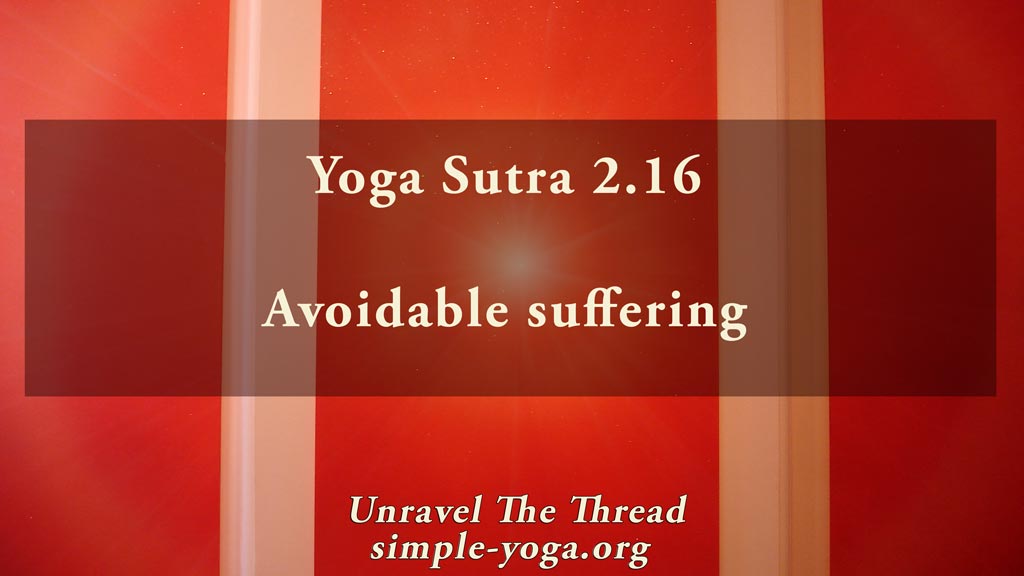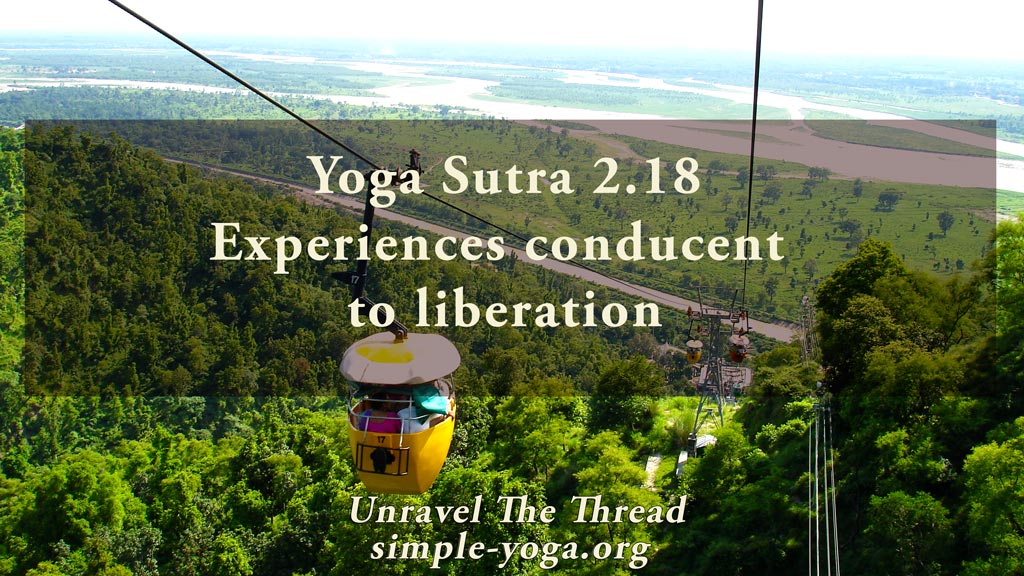
2.16 Avoiding suffering
June 8, 2020
2.18 Experiences leading to liberation
June 22, 2020
2.16 Avoiding suffering
June 8, 2020
2.18 Experiences leading to liberation
June 22, 20202.17 The cause of suffering

2.17 The cause of the suffering that can be avoided is the tendency to conflate awareness with what is experienced.
This is a key verse to understanding the cause of the suffering that can be avoided mentioned in the previous sutra. Suffering is the result of confusing your awareness, your sense of being, with the vehicle of awareness – your organism. Whatever you experience, whatever you can sense, is felt through your organism, through your body, mind and emotions. The awareness that enables you to witness these processes is what brings consciousness to all that you experience. However, the experiences themselves are temporary and ever-changing. These activities and experiences result from being alive and interacting with your environment. As was said before, in verses 1.3 and 1.4, you either abide in your true nature, embodied awareness, or you may identify with your ways of being, meaning that you may think that you are your doing and becoming. In this verse, Patañjali further clarifies that it is precisely this misidentification – conflating the vehicles for experiencing (your body, thoughts and emotions), with the awareness that notices all experiencing – that generates suffering. These ideas from Chapter One and Chapter Two of the Yoga Sutra are connected to verses 2.3 to 2.9, particularly the notions about not remembering your true nature, avidya (2.4).
Contemplate the fact that every night, in order to fall asleep, you let go of all that you usually have on your mind. As you drift into deep dreamless sleep you let go of worries, fears, memories, stories as well as whatever you believe in or think you know. You also let go of your name, your age, your occupation, the balance in your bank account, and everything else. You even let go completely of who you think you are. Despite letting go of all of this, including your own body awareness, you do not disappear. In fact, letting go of all those identifications creates for most people a sense of spaciousness and openness, because those identifications generate bindings and boundaries that manifest physically, mentally and emotionally. This state of being unencumbered by all these temporary distractions is often called the natural state. When the identifications are released, the awareness that animates your body and that also enables you to think, feel, see and interact, is what remains. That awareness is consciousness flowing through you. That awareness uses the body and all experiences as an instrument, yet it is not the instrument.
Yoga is a journey leading you to connect to ever increasing levels of subtlety in your own being. Try this: Every night as you prepare to sleep, consciously choose to let go of all that you will not need during your sleep. Gradually relax into feeling the subtlest aspect of you, from your body, to your breath, to your thoughts and emotions until finally you are only aware of your sensations with no internal commentary or narration. As you experience being, notice that there are sensations as well as awareness registering those sensations without having to qualify them in any way. In fact, you may notice that there are overlapping streams of sensations from sounds and noises outside your abode, to sounds and noises inside your own room, to sounds and noises inside your own body. Simultaneously there may be streams of touch sensations like the texture of whatever is touching your body. You may choose to notice each individual stream from external to internal. Try to just feel each one without describing or narrating. Then try to notice what is the vantage point from where you are witnessing all of this.
In the morning, as soon as you realize that you are awake, even before you open your eyes, notice to what extent your usual internal comments are active. Can you be interested in observing what happens if you keep a gentle connection to the calmness and silence that underlie all your thoughts, beliefs and stories? In the process of releasing thoughts and opinions, notice what are the thoughts that keep coming back or that seem to be more deeply rooted. Explore with curiosity the possibility of choosing which beliefs, opinions and ideas you want to turn off and on. What do you discover? Are some of those thoughts related to who you think you are (asmita), to your likes (raga) and dislikes (dvesha) and to your sense of self-importance (abhinivesha)? How do these thoughts contribute to the quality of your presence? Are these thoughts life-affirming?
As usual, one more way of exploring the meaning of this sutra is by chanting it.
You can choose to chant it in its traditional form with some of the words coming together:
2.17 draṣṭṛdṛśyayoḥ saṃyogo heyahetuḥ
द्रष्टृदृश्ययोः संयोगो हेयहेतुः ॥१७॥
Another option is to chant each word in the sutra individually:
- draṣṭṛ
- dṛśyayoḥ
- saṃyogaḥ
- heya
- hetuḥ
If you prefer, you may listen to the podcast:
Unravel the thread is now available as a book!
If you find Simple-Yoga.org and Unravel the thread useful, consider supporting my labor with a donation, you may also donate using PayPal or Venmo. Thank you!
